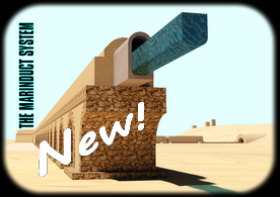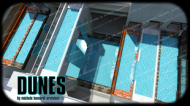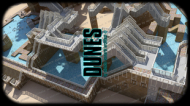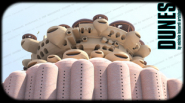VOLUME 1
TOWARD A DIFFERENT HABITAT
VOLUME
2
36 PROJECTS AND REALIZATION OF
LUIGI PELLEGRIN ARCHITECT
An essay by Michele Leonardi
Architect © S.I.A.E. Italy - All rights
reserved.
Translated by Michele Leonardi Architect © All rights reserved.
ABSTRACT
In this e-book named "Toward A Different Habitat: 36 Projects and Realizations of Luigi Pellegrin Architect"
are exposed the principles of Systemic Architectures and
Constructions.
The book consists of two parts. First Volume, "Toward A Different Habitat": words.
Second Volume, "36 Projects and Realizations of Luigi Pellegrin Architect": some exemplary designs of Luigi Pellegrin Architect.
In short, here the basic assumption is
that nature is systemic. And that we can design and build systemic architectures and constructions beyond the form that the same architectures or constructions
can take, because, as is well known, the forms are unlimited. The result will be a form-function that doesn't have to hide behind a mask or behind a label, thus revealing its
essence. In this sense "form follows function". The working method is organic, relational, functional, one more time along the way opened in the past by two of the masters of Modern
Architecture such as Louis Sullivan and Frank Lloyd Wright: the way organic architecture. So it's still valid that nature is the best teacher, "natura naturans", without
for this reason divinizing it. Man and society are not outside nature, but inside nature (Serge Moscovici, 1972), being themselves nature. They are the measure of any
architecture. Let us not forget.
Maybe is the ultimate goal to we be able to design living architectural organisms? No,
because an architecture doesn't need to be a living organism at all, it is another world, but not a world apart, not an empty and dead shell. The ultimate goal is instead to build a language of
contemporary architecture, simple, understandable by all, capable of evolving, thus managing to raise the qualitative level of modern construction practice. Nothing transcendental. In the past men
with two feet, two hands and a head like us have succeeded: Arabs, Japanese, Hindus, Europeans, Khmers, etc. So why on the Earth all of us "evolved", today, continue to produce cities and habitats
that look like cow shit squashed on a meadow? The answer to this question is contained in all the set of pages that follow. There is no slogan, magic, miracle, flash of genius, but only research and
continuous work.
If the Systemic Habitats' intents will be emulated in the future, this will be one more step towards liberation
from current building practice, given by inhuman piece's logic, the sum
that is never a sum, which results in the anonymous modern
cities: “the grandma's old pie crust”, as rightly Frank Lloyd Wright called them, more or less.
The name for the theme we are dealing
with here is not random. Habitats indicates the spaces of living, the places where people live and carry out their
activities; from the basic living cell, to the
architectural organism, up to the urban and territorial scale. While the adjective Systemic indicates that the components of a given architecture or construction make system with each other.
M. L.
PREFACE
The idea of Systemic Habitats in architecture and constructions matured in me
around 1997-2000. Tidying up, together with my colleague Marco D'Arpino, the project archive of Studio Luigi Pellegrin. Then, realizing that as yet there was no book on Pellegrin's considerable work.
And then, it must have been around 1998, because of Pellegrin's words. In fact, while my colleagues and I were working on the executive project of Palace of Justice in Mantua, in particular on the structural connection nodes in steel, the Master told me, but this did not apply only to me, making himself heard by all the others
present: "the components must form together a system". Then, relating everything, the conviction that the Master's work was "systemic" arose in me. Systemic, as
well as organic. Indeed, it is the same thing. "Systemic" and not "systematic", because it is not a procedure, it is not an algorithm, it is not a formula. It is
continuous research, there are no shortcuts.
This essay discusses innovative housing models and systemic architecture.
But also about the organic architecture, as well as in my opinion overtly systemic architecture, of Luigi Pellegrin. What systemic architecture is - I am in fact not referring to simple
prefabrication, the Reader will be able to understand for himself by reading all my book, which consists of two parts, one complementary to the other.
The first volume - which could be titled "Toward a different habitat" and stop - is the actual text, in which certain concepts are given dissected and described in a
way that is understandable even by the uninitiated. This first part also serves as an introduction to a certain extent to the works and thought of Luigi Pellegrin, thought filtered and integrated
together with the opinions and beliefs of the writer, unless it has been clearly specified by me that it is His thought. It is almost unnecessary to emphasize that urban renewal is not a separate
dimension of doing architecture, and therefore falls seamlessly within the scope of defining new housing models, that is, responding to the needs of contemporary living, but according to a norm that
is always that of human measure and not that of the times and ways of machines.
The second volume could only be
titled as "36 Designs and Realizations of Luigi Pellegrin Architect”, and it contains the illustrations, or rather drawings and documents illustrating 36 particular designs and realizations
of Luigi Pellegrin, very little in fact compared to his vast volcanic output, and those who know his works well know what I am talking about. These 36 Designs of Pellegrin demonstrate, more than a
thousand words, what can be meant by "systemic architecture."
Always concerning the second
volume, the Reader will notice a certain degree of “unfinished" in the illustration of the 36 works by Luigi Pellegrin of relevant interest. Such unfinished is not due to the laziness of the
Author, but is intentional. In fact, from 2012 to the present I would have had plenty of time to complete rather than expand the content of the Systemic Habitats website.
This is intentional for two simple reasons: both
because the unfinished hints at open patterns, new possibilities, at what is alive and therefore present, both because Pellegrin's architecture is never reducible to a cliché. And so the unfinished
is fully pertinent. So: unfinished as infinite, unfinished as alive, present, an open construction site, still capable of generating something new and unknown to us.
But all systemic architecture, if this
aspect of architecture is ever to have a following, must perforce remain open pattern, an continuous research, and not yet another formalism or theory disconnected from the happily pragmatic
reality of the architecture: living with change. Change in the lives of people, families, and societies. Abstruse concept? No, obvious, because without change there can be no life, no past, present,
future, history, nor anything of significant. In short, it is easier to say what is not "systemic architecture", that is, once again, what is not "organic architecture": it is not fashion, it is not
sculpture, it is not ideology.
Criticizing certain realities of contemporary culture and civilization is not the
same as demonizing everything and everyone, nor to throw the baby out with the bathwater. Extremisms and prejudices do not interest us. If the Reader sometimes encounters a polemical tone, this is
for a good purpose: to demolish clichés, offering the Reader inputs, suggestions to know or do something different from the usual building practice "of the piece", we hope. All texts should not be
read "with a magnifying glass", but with one's own eyes.
Other: I could have reduced this manuscript of mine by many pages, but everything
would have seemed to have fallen from above without an apparent cause. So to avoid any dogmatism and any ideological maximalism, I preferred to keep everything discursive, fluid, a sort of chat
between friends, avoiding hermeticism where possible. And then a consideration: after all, excluding notes, references and bibliography, the text is just about 150 pages in total. The minimum to deal
with certain topics and to be understood.
What's more... As suggested by Roberto Vacca, engineer, mathematician,
futurologist, science communicator and Italian writer, in his book “Memi”: any essay can also be read by zapping, therefore jumping from one chapter to another, but above all starting from the parts
that interest us moreover. The same goes at least for this essay: I authorize you "to sin".
This book was essentially written around the distant year 2000 and later published
as an electronic book via the internet in 2012 on the Systemic Habitats website, initially created exactly for its publication. After and until 2021 several minimal changes were made, mostly as an
update of the bibliographic references and some crucial insights; while in retrospect I still think this book is valid and actual in all its contents.
M. L.
CONTENTS OF VOLUME 1
01 Do we want a different
habitat?
02 Sustainable development and
architecture.
03 Methodology of systemic architecture.
04 Systems
integration.
05 Fragmentation and
change.
06 What is a
habitat.
07 The return to
nature.
08 The city, a superable way of
living.
09 The urban
renewal.
10 The forgotten architecture:
The innovative housing models of '70s.
11 Today's
models.
12 Towards a different
habitat.
Bibliography.
S.I.A.E. tutti i diritti riservati © Dott. Arch. Michele
Leonardi
S.I.A.E - Italy, all rights reserved ©
Michele Leonardi Architect


































